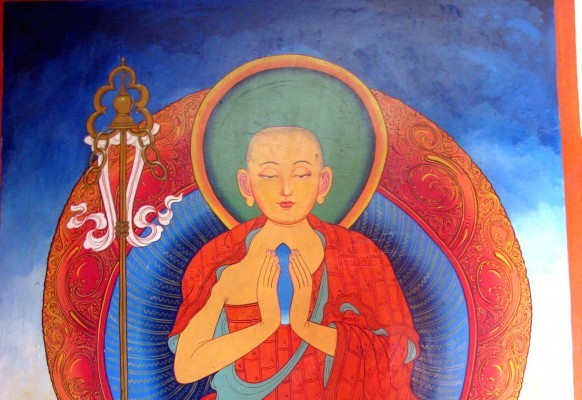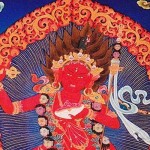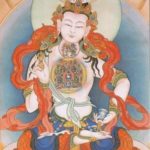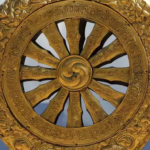The Story of Gelongma Palmo (Tib. dGe slong ma dPal mo)
The historical stories of Tibetan Buddhist women often contain shocking elements which blatantly address the difficulties of life and how Buddhist teachings can be integrated into real life circumstances. Such dramatic narratives can make philosophical points in a way that an intellectual argument never could, by evoking unforgettable imagery, eliciting emotion and through their vivid portrayal of shocking elements, which demand a reaction on the part of the reader.
One of the key themes of Buddhist life stories is that our experiences are not only made up of circumstances, but also of our reaction to those circumstances. Whatever happens externally may not be in our control, but we have a choice about the meanings we take from them and where we go from here. This is a Buddhist viewpoint made apparent by the radical story of Gelongma Palmo, who faced extreme hardship, yet is subsequently transformed and liberated through the experience.
Long ago, in tenth or eleventh century, legends tell of a Buddhist nun who came to be known as Gelongma Palmo. She was a princess from Kashmir who, due to her great beauty, could have been married to kings from neighboring countries but decided instead to become a Buddhist nun. Because of her aptitude for study, her teacher appointed her as a head of the monastic community. But the boons of her early life could not have foreshadowed the horrors she would have to endure.
Buddhists meditate on impermanence as a primary feature of their practice, but it was a surprise when at the young age of twenty five, Gelongma Palmo discovered a small boil on her foot. She continued her work in the temple, ignoring it. But, as her boil grew into a blister, she began to witness her body succumbing to a nightmarish affliction. The blister spread and gradually consumed more and more of her body, which was increasingly filled with unbearable pain. After her feet fell off, it was clear that she her body was decomposing due to leprosy. Initially, through the help of her attendant, she hid her condition. But then, when her fingers fell off, gradually it became apparent to everyone around her what was happening.
<<She and her attendant were promptly thrown out of the community. As is the case with many serious illnesses, she suffered not only the deterioration of her body, but the sadness and isolation left by the loss of social connections. Illness does not necessarily discriminate between young and old, religious or not, good or bad person. Gelongma Palmo had been a very noble person. She lost her beauty, she lost her toes, lost her fingers and could only move by crawling.
However, Tibetan Buddhist stories emphasize that our experiences are not only made up of circumstances but also of our reaction to those circumstance. Gelongma Palmo, facing what would be anyone’s worst nightmare, did not let herself fall into resentment, but instead generated bodhichita, enlightened intent. As a result, she had a vision of Avalokiteshava, the Buddha of compassion. She then made a vow to the Buddha of compassion, that she would remain in one place meditating until she attain the highest realization. And so she remained. She fasted without food or drink. She remained completely silent. Whatever inner demons hounded her during that period, she sent them compassion and therefore they were subdued. One year later, like a snake shedding a skin, her leprosy was cured. Her biography says that she became, “even more beautiful than before.” She discovered the true source of beauty, a compassionate, altruistic heart an enlightened intention, with the wish for the benefit of all beings. It is said that after that many people saw that she was a dakini, a highly realized woman. After her life, the practices she engaged with became her legacy. That fasting and meditation practice was carried on by both male and female practitioners alike, monastics and lay practitioners, making Gelongma Palmo one of the few Tibetan Buddhist women who was the founder of a major Tibetan Buddhist practice.
The fasting ritual (Tib. smyung gnas) and meditation practice of Gelongma Palmo is practiced widely still today as a popular fasting system for purification of karma. It features the visualization of the Buddha of Compassion, Avalokitesvara, along with a ritual of renunciation, prostrations and recitation.
Apparently Gelongma Palmo’s earliest biography dates back to the fourteenth century by jo gdan bsod nams bzangpo – the smyug gnas bla ma brgyud pa’i rnam thar. An overview of the various versions of her life can be found in a fascinating article in the Journal of International Association of Buddhist Studies, Volume 24, Number 2, 2001, by Vargas-O’Brian.
Footnotes
(1) Vargas-O’Brian 162
References
Havnevik, Hanna, Tibetan Buddhist Nuns: History, Cultural Norms and Social Reality (Oslo: Norwegian University Press, 1989).
Karma Lekshe Tsomo, “Tibetan Nuns and Nunneries,” Feminine Ground: Essays on Women and Tibet, ed. Janice D Willis (New York: Snow Lion Publications, 1987), pp.120-121
Price-Wallace, Darcie. “Gendering Nyungne: The Tibetan Buddhist Fasting Ritual,” Sakyadhita 14th International Conference on Buddhist Women; Compassion and Social Justice (Sakyadhita, 2015)
Vargas-O’Brian, Ivette M. “The Life of dGe slong ma dPal mo: The Experience of a Leper, Founder of a Fasting Ritual, a Transmitter of Buddhist Teachings on Suffering and Renunciation in Tibetan Religious History.” Journal of the International Association of Buddhist Studies 24.2 (2001): 157-185.
Image Source
https://alishaadhikari.files.wordpress.com/2014/06/1a.jpeg










